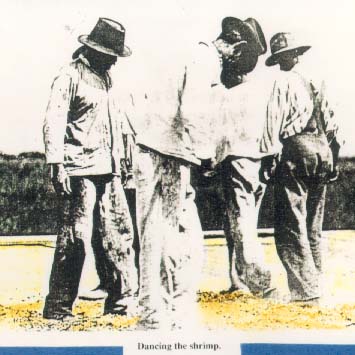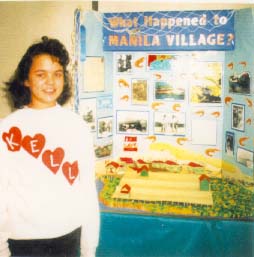
Platformworkers trampled on the shrimps to remove the head and the hulls. Thisunusual procedure was called "Dancing the Shrimp."
What Happened to Manila Village?Sorry,
you need a Java capable browser to see this.
As New Orleans assess damage created by a
hurricane named Georges that has
Already killed hundreds, citizens are making
mass efforts to restore their
belongings: houses, farms, businesses, and
land. Very few are probably worried about any remote possibility
of the loss of an entire cultural existence.
Yet it was only about thirty years ago that
hurricane Betsy,
following the same route as George, did exactly
that and swept away
the tiny Manila Village.
Today's up-to-the-minute meteorological
technology
and the modern uses of wood, sands, and steel
barriers probably
couldn't have protected this small Filipino
fishing village, made up of long
platforms that stretched across the tiny island
known as Manila
Village south of New Orleans. The place, barely
above sea level, was no match
against the rising 18-foot swells pounding
the gulf coast brought by
the Hurricane Betsy in Sept 9, 1965.
By Kelly Welch
Abstract-Before
I can answer the question,"What happened to Manila Village?" I must first
explain what Manila Villagewas.
The main productof
this village, a settlement from before the turn of the century, wasdried
shrimp. It was an important resource to the economy then and alsowell into
the 20th century. The shrimps were harvested in Barataria Bay(where Manila
Village was located and sent to New Orleans for export toAsia, Canada,
and South and Central American.
Most of my
informationwas acquired from conversations with my grandmother, who spent
her earlylife and many of her summers there. Also, a personal interview
with Mrs.Marina Espina, the author of the book "Filipinos in Louisiana"
was an invaluableresource for the project. I also gathered information
from books, periodicals,and newspapers.
Report:Nestled in Barataria Bay, Manila Village was just a few miles southeastof Lafette, fifteen miles north of Grande Isle, and fifteen miles southof Myrtle Grove. Manila Village was home of Filipino seamen and fishermenfor more than a century.
Manila Villagewas the largest, oldest, and most popular of the shrimping villages inthe bay. The dozen or so red-roofed, green painted buildings, that madeup the village were built on stilts at the edge of the bayou, constitutingwhat was called "the platforms." The platforms built in a series of slopeswith volleys between, to drain away excess water. They were the size oftwo football fields. Manila Village was named after the capital city ofthe Philippines. It was built on hand-driven pilings spread over fiftyacres of marshland. The village had warehouses, a fuel dock, shelters forplatforms workers, a general store, homes, and a post office called "Cabinash."Cabinash Island was across a small bay south west-like a suburb of theVillages.
Many trawlerscontributed their daily catch to the platforms. Trawlers were "lugger"type boats that dragged a trawler along the sea or gulf bottom. All trawlershave to obtain a yearly license and display it at all times.
After thecatch, everything except the shrimps were returned to the sea. The shrimpswere then delivered
To the villagefor "washing" and boiling.
The sun-dryingof shrimp, a method developed in the Philippines, was the chief occupationof most residents. This process required many stages. First, the shrimpswere boiled for twenty minutes in copper caldrons containing coarse saltand water. Then, they were spread out to dry in a single layer on the hugeplatform. At regular intervals, they were "stirred with long, wooden rakesto ensure uniform drying. The process took three or four days in the summer,and five to ten days in the winter.
The shrimpswere
raked to the top of the slopes and covered with tarpaulins at nightor during
rainy weather.

Platformworkers
trampled on the shrimps to remove the head and the hulls. Thisunusual procedure
was called "Dancing the Shrimp."
Louisianawater yielded half the shrimp consumed in the United States, and ManilaVillage ranked as one of the top producers of dried shrimp.
Conclusion: But,"What happened to Manila Village?" you may ask. Well, it was blown awayin 1965 by a devastating hurricane called "Betsy."
Mrs MarinaEspina went to look for Manila Village in 1976, but all that was left standingwere pilings and one camp. Now there are only pilings left.
By doingthis
project and researching the background of Manila Village, I have learnedthat
because of the destruction of this shrimping village, many Filipinoshad
to turn to deep-sea shrimping, freezing shrimp or to other occupations.Shrimp
drying has become a commercial endeavor. Tidal waves and strongwinds may
have swallowed the whole settlement, however, the waters couldnot wash
away the rich tradition of the early Filipino settlers. The descendantsof
the people of Manila Village are proud of their heritage and their forefathers,who
made outstanding contributions to the history and economy of the Stateof
Louisiana.
KellyWelch, New Orleans 1992
This is a Social Studies Project
by Kelly Welch. Shewon First Place in her school and at the regional Social
Studies Fair.Her grandmother, Isabel "Riggie" Gedoria Welch was the New
Orleans Teacherof the Year in 1976. Her aunt become a school principal
and also has adaughter, Cecilia Ann Dartez, who is a former teacher. Cecilia
now writesbooks for children and series on the Internet. Ann's "Jenny Giraffe"
seriesis on the internet and New Orleans Library. Another cousin taught
for manyyears at Tulane University. Teaching seems to run in this family.
Riggie retired twice from teaching but continued tovolunteer as Mother Goose, reading stories to kindergarten and first-gradeclasses at Dwight D Eisenhower School in Algiers, New Orleans.
It was an end of an era, a way of life for those sea dwellers mostly
from the Southern Philippines who found the bayous similar to the islands
in the Philippines. The region's climactic similarity to the
Philippines and its rich bounty of marine products lured these Filipinos.
The abundance of these resources may have attracted these fishermen who
had the knowledge to harvest and market these products. I myself
had not seen the village but I was very excited when Ms Isabel Gedoria
Welch who spend most of her early
summer of her life in the island told me about her experience.
Her father
heard of the existence of Filipino community in New Orleans while he
was serving in the WW1. After the war he found his way to New
Orleans
and married a Filipina who became Isabel's Mom.
Isabel's older sister went with the men to village to assess the damage
in the
hurricane aftermath and found everything was gone.
All that
remained were piles and rift rafts. The sea dwellers started to moved
inland
and adapted a much easier life. She is now a retired schoolteacher
and
her sister became a school principal. You will never see another girl
prouder of her heritage.
Names of powerful killer Hurricane like Andrew, Betsy, Camille, and
Georges are retired forever as a point in History. Betsy for sure
made her mark in Fil-American History.
The Manila Village will be featured in the upcoming issue of
HERITAGE MAGAZINE.
Nestor Palugod Enriquez